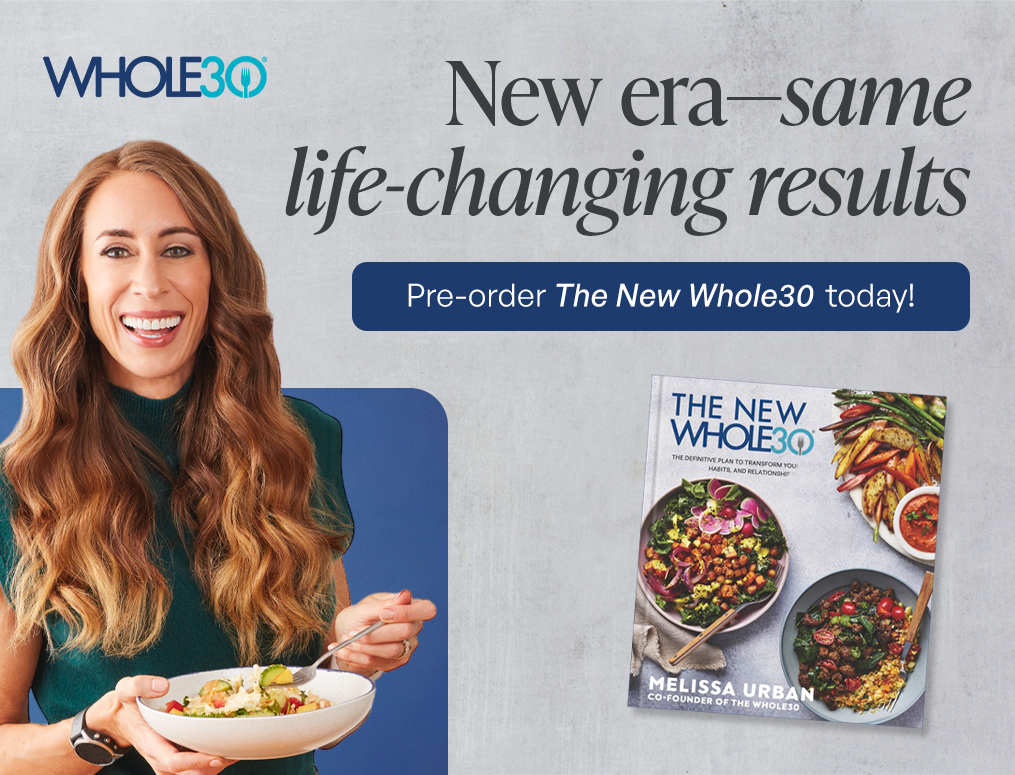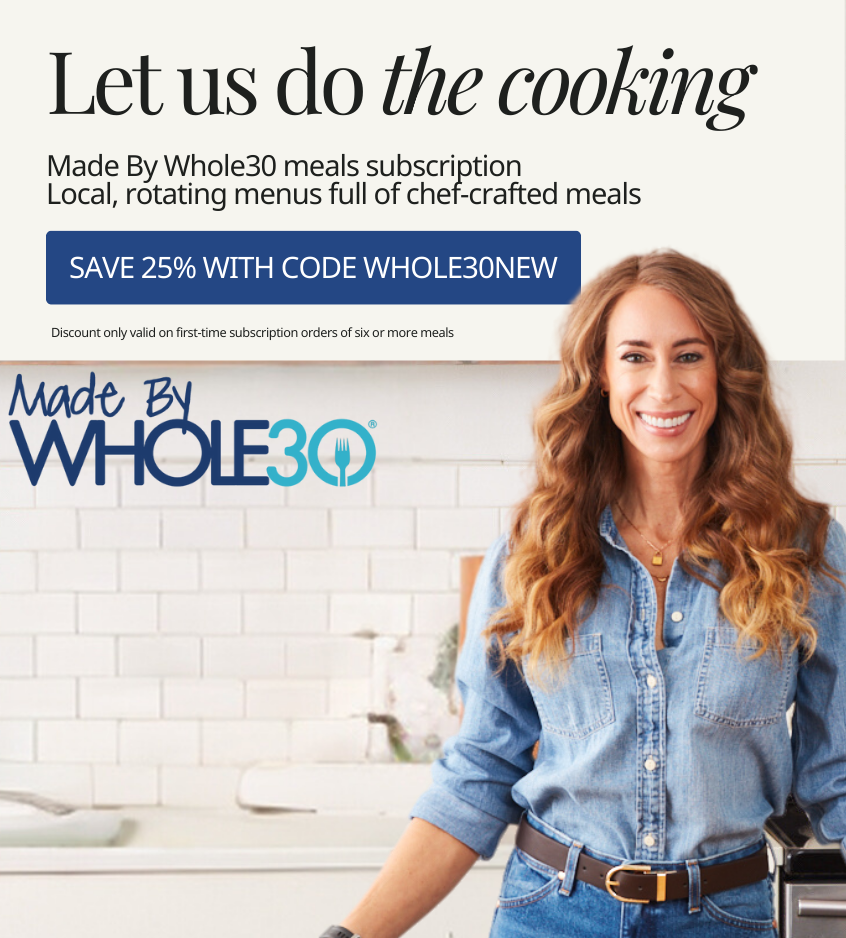Dear Melissa,
I know you caution against tracking food on the Whole30. However, I feel stressed and unsettled if I’m not tracking, even though I consciously know I am eating well and taking care of my body. I have a lot of weight to lose, so not tracking makes me anxious—like I’m not being accountable, even when I am. (Old wounds.) Do I push forward and ignore the anxiety, or stick to the tracking? –Liz, via Instagram
Dear Liz,
Thanks to the popularity of My Fitness Pal and the relentless pressures of diet culture, I get this question often. First, let’s talk about why tracking, logging, and analyzing your calories or macros is discouraged on the Whole30.
Why We Say “don’t measure, count, or track”
As I wrote in The New Whole30, one goal of our program is to get you back in touch with your body’s natural regulatory mechanisms. In this case, trusting your feelings of hunger, and intuitively knowing when to stop eating. During the program, we encourage you to eat whenever you’re hungry, and stop when you’ve had enough. And because of the foods you’re eating (and not eating) during elimination, with time, these signals will actually work—perhaps for the first time in years!
Our dietitians have also provided you with a meal template to aid your meal planning for the first week or two, until you have a handle on how big your meals should be. Our template accounts for variability in body size, activity level, and goals, such that you won’t need to count or measure your food to ensure accountability. Just eat Whole30 food, follow the meal template for guidance as needed, and I promise, you’re succeeding!
Note, the admonition against tracking is just a recommendation, not a program rule. However, we’d caution you against it for the same reasons we caution against the scale. Your body knows how much you should be eating better than any calculator on the internet. In addition, most of us have been so conditioned to restrict calories or macros that even though you feel amazing, you may still be tempted to restrict further once you see the numbers.
- SUMMARY: Take a break from the weighing, measuring, and tracking during the Whole30. This will help you foster a healthier relationship with food; and turn mealtime into a relaxing, enjoyable experience instead of an arbitrary math session. Shift your idea of “accountability” to “I will stick to the Whole30 Program Rules during elimination, and complete a careful, systematic reintroduction.”
Your tracking intervention
Now talk about three strategies for weaning yourself off tracking and logging without adding stress to your Whole30, in order of most effective to least effective when it comes to Whole30 success.
Strategy 1: Cold turkey
I strongly prefer a “rip the Band-Aid” approach. I know tracking feels like a security blanket, and that you have a weight loss goal. But tracking may be holding you back from the very thing you’re hoping to achieve. And if you try to turn the Whole30 into a weight loss diet, you’ll lose on both ends.
Being focused on the numbers keeps you tuned out to the signals your body is trying to send you—“I’m hungry,” “I’m craving,” “I’m dragging in the gym.” And until you actually get back in touch with your body’s natural regulatory mechanisms, you’ll never truly find food freedom.
With this approach, you stop tracking now, and use our meal template and your energy levels, hunger, focus, and athletic performance to help you build your meals. If you’re consistently hungry between meals, make each meal a little bigger until it’s just right. If you need a snack between meals, have a snack. If you feel stuffed after breakfast, take a smaller portion next time, then wait 10 minutes and decide whether you want more. If you’re tired or your energy is flagging, add more fruit or potatoes, a little more fat, or both. Chew slowly, eat mindfully, and listen.
Strategy 2: Track, but only for a few days
If cold-turkey seems too scary, here’s an in-between solution: Track using whatever methodology and program you’re used to using, but only for a few days. This will confirm that you’re on the right track with your Whole30 meals, but encourage you to stop tracking and reconnect with your food and body for the remainder of your program.
I’ve used this strategy with those I suspect are eating too little. They think they’re eating so much food (because it’s all very satiating), but when they get it into a calculator, it’s clear they’re coming up short. This can be a valuable experience—but one that doesn’t have to be repeated over and over again. Track, observe, then adjust and move on.
This can backfire, however, which is why it’s not my top choice. If your normal diet is low-calorie (or calorie-restricted) and you start seeing those numbers in your tracker go up, it can feel scary. You may feel tempted to restrict again—which can backfire, leading to a slower metabolism, increased hormonal disruption, stronger cravings, and fewer Whole30 NSVs.
If you take this approach, commit to tracking only for the first few days—and then trust the Whole30 process. You may find incredible freedom in abandoning the tedious task of documenting every single bite, and you can always return to your healthy, sustainable weight loss efforts (and tracking, if you choose) when elimination and reintroduction is over.
Strategy 3: Keep tracking, with caveats
If you feel like you really need to keep tracking as thoroughly as you are used to for the entirety of your Whole30 (which I’ll strongly recommend against), I’m going to assign you additional homework. Along with your intake, I also want you to journal how you feel after each meal, and between meals. This can be done in your Notes app, tracking app, or on paper. And I want you to be honest.
It’s extra work, but it will help you reconnect with your body while tracking. My hope is that once you see that your calories look “high” but you’re feeling energetic, sleeping well, not hungry between meals, not bloated, and feeling zero cravings, you’ll be more comfortable trusting the process and letting your daily tracking fall by the wayside. (Conversely, if your calories look “right” but your energy is lagging, your cravings are strong, you’re hungry all the time, and you have little motivation to exercise—that’s some strong motivation to start trusting your body over the numbers.)
Note: If your calorie tracking starts taking your Whole30 in an unhealthy direction, where you find yourself restricting even further or struggling with your mental health, please discontinue the program (and your tracking) and consult a trained therapist or healthcare provider.
Remember, it’s a process
The Whole30 is about so much more than just changing the food you put on your plate. There are a lot of factors that go into attaining food freedom, and evaluating your relationship with calorie tracking is one of them. You’re already off to a great start here, just by asking the question. I’m confident you’ll succeed with the Whole30 while staying accountable to your commitments.
Work through one of these solutions as you are able, stay focused on your Whole30 NSVs, and remember to celebrate the small wins along the way. Stay in touch with our community, and ask for support whenever and wherever you need it. We’ve got you, and you’ve got this.
Best in health,
Melissa
Disclaimer: This page contains affiliate links. We earn a small commission when you purchase through these links.


















